The Effect of Design Rainfall Patterns on Urban Flooding Based on the Chicago Method
Abstract
1. Introduction
2. Materials and Methods
2.1. Overview of the Study Area
2.2. Data
2.2.1. Lower Bedding Surface Data
2.2.2. Design Storm Calculations
Storm Intensity Formula
Design Storm Extrapolation
2.3. Model Construction and Validation
2.3.1. Model Construction
2.3.2. Model Validation
3. Results and Discussion
3.1. Total Waterlogging Analysis
3.2. Inundation Extent Analysis
4. Conclusions
Author Contributions
Funding
Institutional Review Board Statement
Informed Consent Statement
Data Availability Statement
Conflicts of Interest
References
- Hu, C.; Yao, Y.; Liu, C. Influence of rainfall rain patterns on urban flooding. Water Resour. Conserv. 2022, 38, 15–21+87. [Google Scholar]
- Soomro, S.; Hu, C.; Boota, M.; Wu, Q.; Soomro, M.; Zhang, L. Assessment of the climatic variability of the Kunhar River Basin, Pakistan. Water 2021, 13, 1740. [Google Scholar] [CrossRef]
- Soomro, S.; Hu, C.; Jian, S.; Wu, Q.; Boota, M.W.; Soomro, M.H.A.A. Precipitation changes and their relationships with vegetation responses during 1982–2015 in Kunhar River basin, Pakistan. Water Supply 2021, 1, 2166. [Google Scholar] [CrossRef]
- Hu, C.; Liu, C.; Yao, Y.; Wu, Q.; Ma, B.; Jian, S. Evaluation of the impact of rainfall inputs on urban rainfall models: A systematic review. Water 2020, 12, 2484. [Google Scholar] [CrossRef]
- Chen, J.; Li, Y.; Zhang, C. Urban Flooding Prediction Method Based on the Combination of LSTM Neural Network and Numerical Model. Int. J. Environ. Res. Public Health 2023, 20, 1043. [Google Scholar] [CrossRef]
- Xu, Z.; Ye, C. From “city looking at the sea” to “city looking at the river”: Simulation and risk analysis of flood and waterlogging process in Fuzhou under extreme rainstorm scenario. China Flood Drought Manag. 2021, 31, 12–20. [Google Scholar]
- Li, Z.; Liu, Y.; Ren, X. Research on urban flood risk management based on SWMM. Water Resour. Hydropower Eng. 2019, 50, 35–42. [Google Scholar]
- Li, J.; Li, Y.; Shen, B. Simulation of rain garden effects in urbanized area based on SWMM. J. Hydroelectr. Eng. 2014, 33, 60–67. [Google Scholar]
- Liu, Y.; Yang, M.; Xu, J. Analysis and research on urban rainstorm patterns in Hangzhou. Bull. Sci. Technol. 2021, 37, 15–22. [Google Scholar]
- Wang, T.; Bao, Y.; Chen, C. The design of the short-duration rain pattern of the rainstorm in Kunshan City. J. Meteorol. Sci. 2021, 41, 259–269. [Google Scholar]
- Tang, M.; Xu, W.; Yao, J. Research on design rainstorm pattern based on numerical simulation of urban waterlogging. China Water Wastewater 2021, 37, 97–105. [Google Scholar]
- Zhao, L.; Wang, B.; Bai, X. Research on urban rainstorm typing and short calendar rainfall recurrence period in Beijing. In Proceedings of the 2016 Conference of the Chinese Meteorological Society, The 33rd Annual Meeting of the Chinese Meteorological Society, Xi’an, China, 2–4 November 2016. [Google Scholar]
- Wang, D. Simulation of Drainage and Waterlogging Prevention in Haicheng City based on double peakrainfall pattern. In Proceedings of the National Drainage Committee, 2015 Annual Meeting, Water Industry Branchof China Civil Engineering Society Drainage Committee, Hangzhou, China, 31 October–2 November 2015; Volume 5. [Google Scholar]
- Forestieri, A.; Caracciolo, D.; Arnone, E. Derivation of rainfall thresholds for flash flood warning in a Sicilian basin u-sing a hydrological model. Procedia Eng. 2016, 154, 818–825. [Google Scholar] [CrossRef]
- Pedrozo-acuna, A.; Moreno, G.; Mejia-estrada, P.; Paredes-Victoria, P.; Breña-Naranjo, J.A.; Meza, C. Integrated approach to determine highway flooding and critical points of drainage. Transp. Res. Part D Transp. Environ. 2017, 50, 182–191. [Google Scholar] [CrossRef]
- Tang, S.; Luo, W.; Jia, Z. Effect of rain gardens on storm runoff reduction. Adv. Water Sci. 2015, 26, 787–794. [Google Scholar]
- Handbook for the Calculation of Storm Floods in Small and Medium-Sized Watersheds in Sichuan Province; Sichuan Provincial Department of Water Resources and Electricity: Chengdu, China, 1984.
- Zhoukou City, Henan Province Urban Master Plan (2016–2030); Municipal Bureau of Natural Resources and Planning: Zhoukou City, China, 2020.
- Notice on the Publication of the Formula for the Intensity of Rainstorms in the Central City; Office of the People’s Government of Zhoukou City: Zhoukou City, China, 2022.
- Keifer, C.; Chu, H. Synthetic storm pattern for drain-age design. J. Hydraul. Div. 1957, 83, 1–25. [Google Scholar]
- Ren, M.; Xu, Z.; Chu, Q. Simulation of rainstorm and waterlogging in the overpass area of Lixia District, Jinan City. S. N. Water Transf. Water Sci. Technol. 2018, 16, 9–15. [Google Scholar]
- Liu, X.; Wang, T.; Zhang, Q. Comparative study on isostream time line models of EPA SWMM and Mike Urban. China Water Wastewater 2017, 33, 30–35. [Google Scholar]
- Luan, M.; Yuan, W.; Liu, J. Risk assessment of waterlogging in Tonglu County based on SWMM-MIKE11 coupled model. Water Resour. Prot. 2016, 32, 57–61. [Google Scholar]
- Lu, L.; Pan, X.; Zhang, L. Validation of MIKE FLOOD model in flood simulation of Qinghe River Basin in Beijing. Water Resour. Hydropower Eng. 2021, 5, 148–151. [Google Scholar]
- Zhang, Y.; Hao, M.; Fang, Q. Simulation of flood control and drainage in newly-built urban areas based on Mike Flood coupling Model. China Rural Water Hydropower 2021, 23, 15–18. [Google Scholar]
- Luan, Z.; Jin, Q.; Zhao, S. Research on waterlogging in typical urban areas based on MIKE FLOOD coupling model. Water Resour. Prot. 2021, 37, 81–88. [Google Scholar]
- Kong, Y.; Sun, W.; Li, X. Application of SWMM-MIKE 11 coupling model in sponge channel construction. Water Resour. Prot. 2021, 37, 74–79. [Google Scholar]
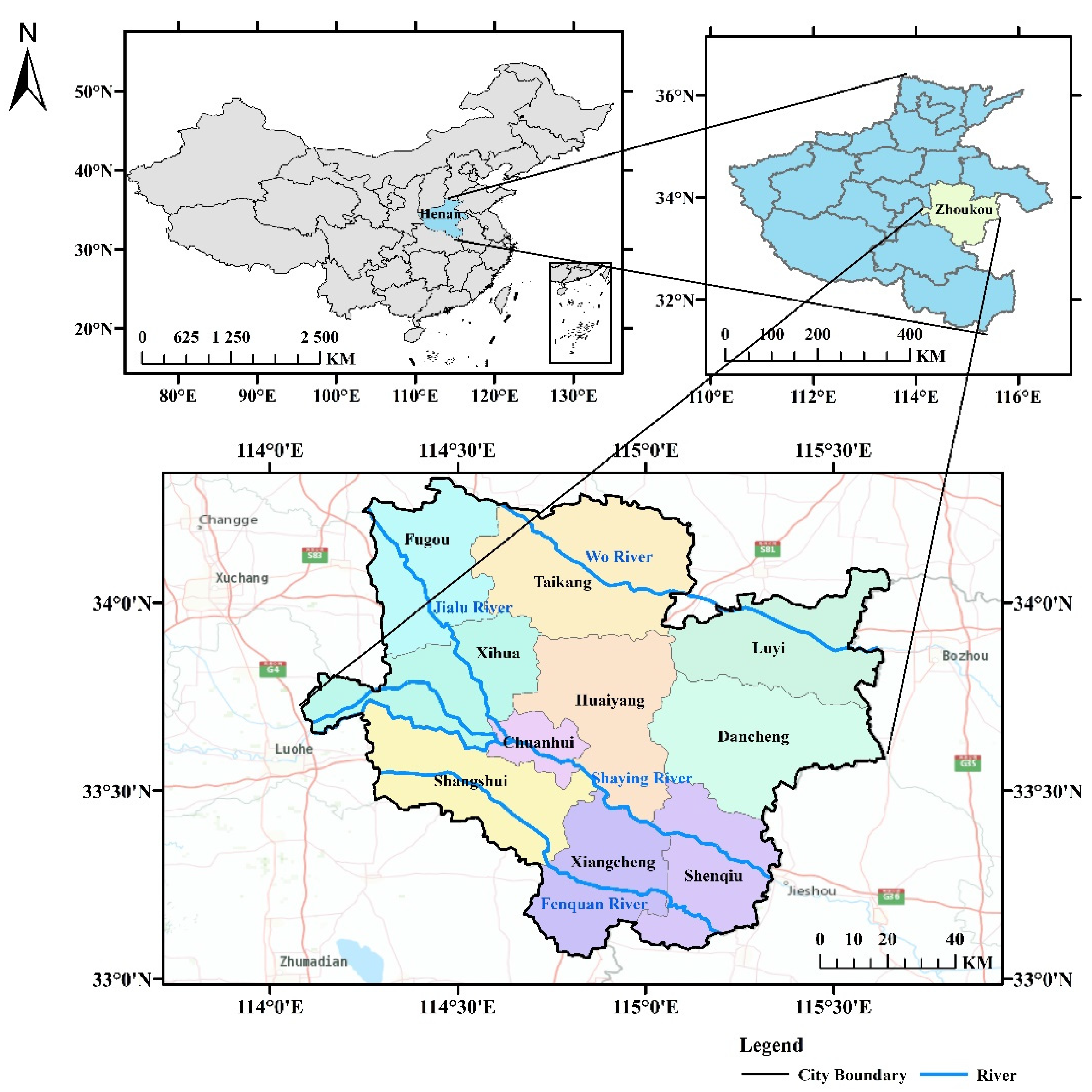
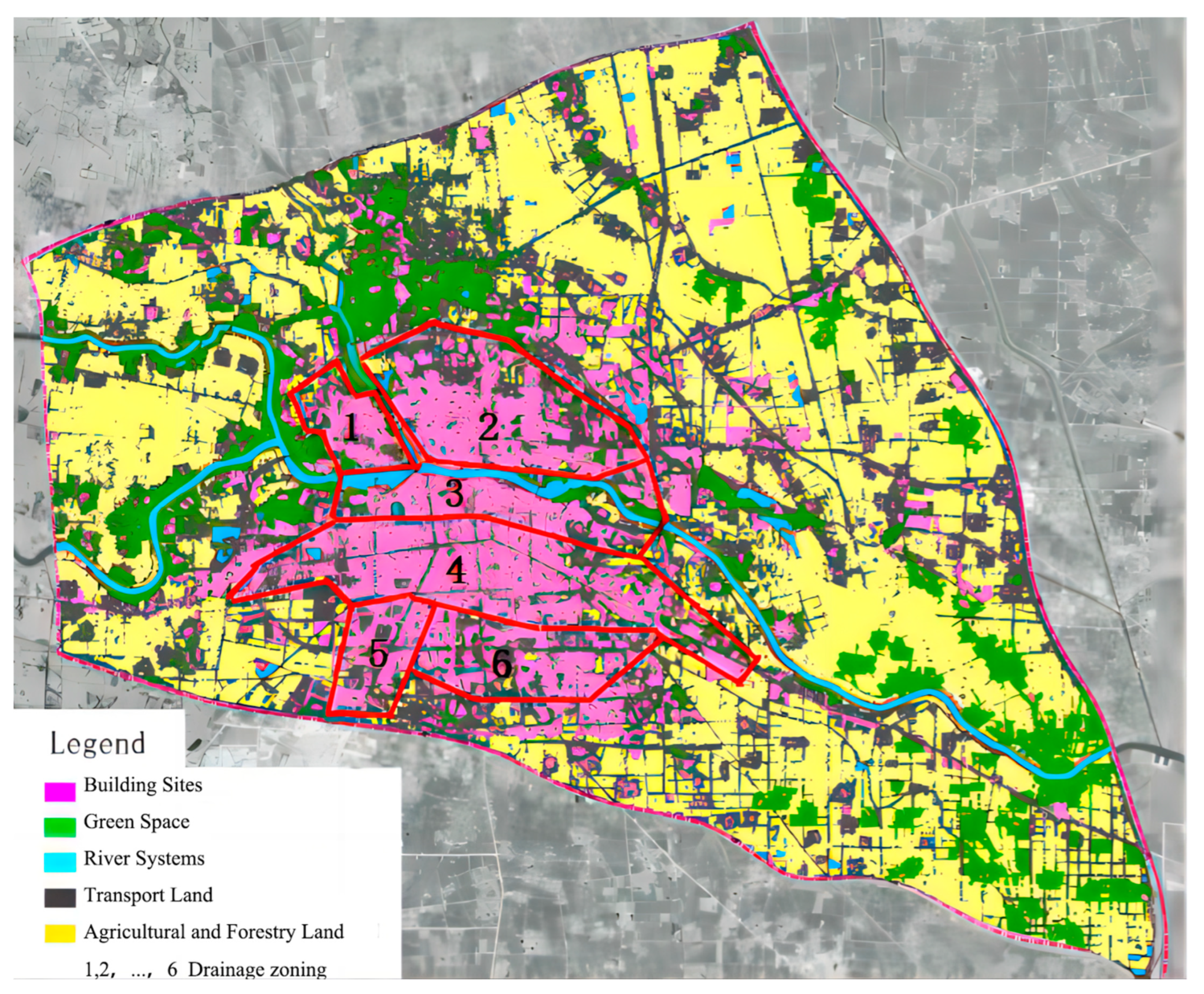

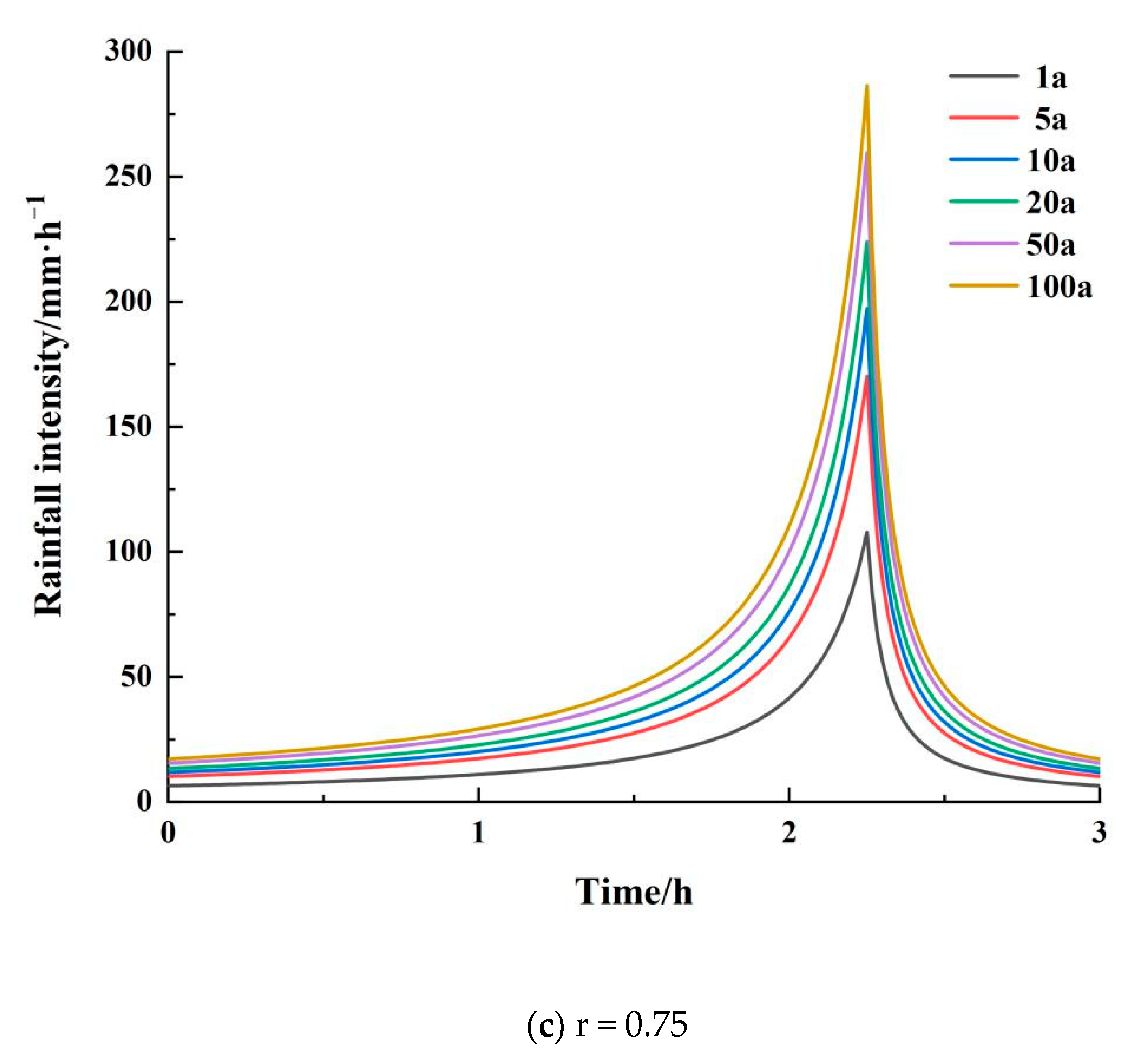
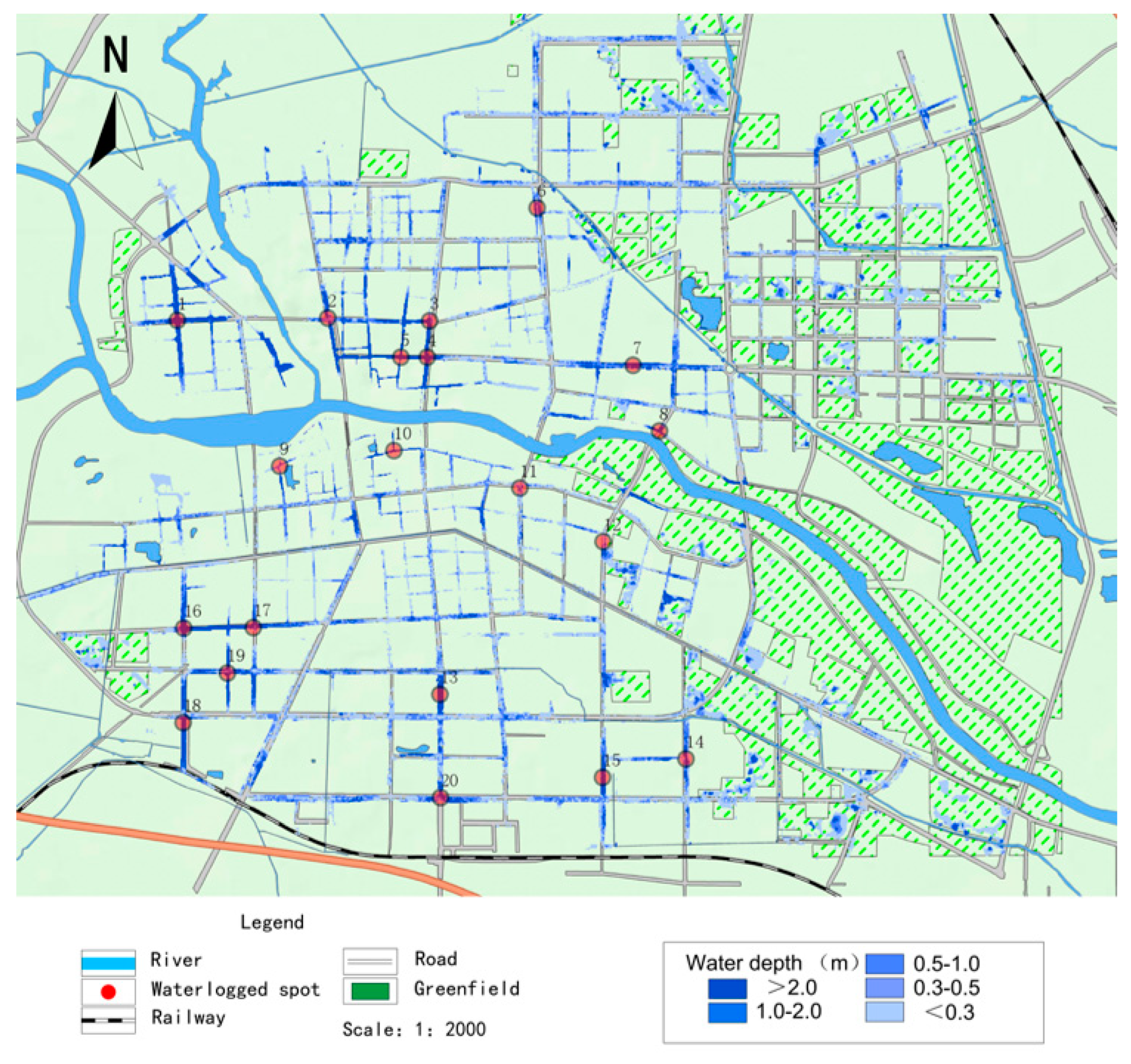
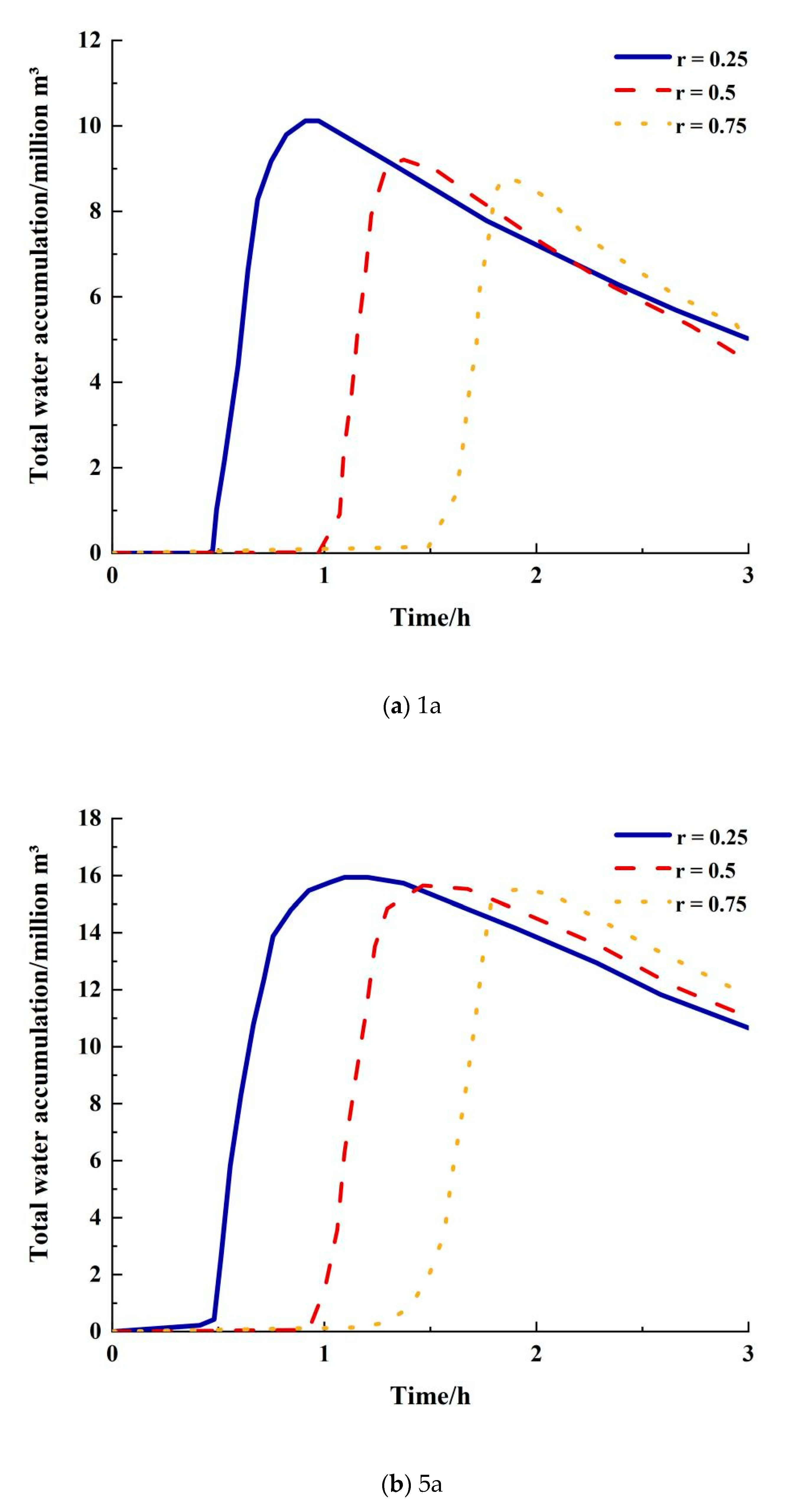

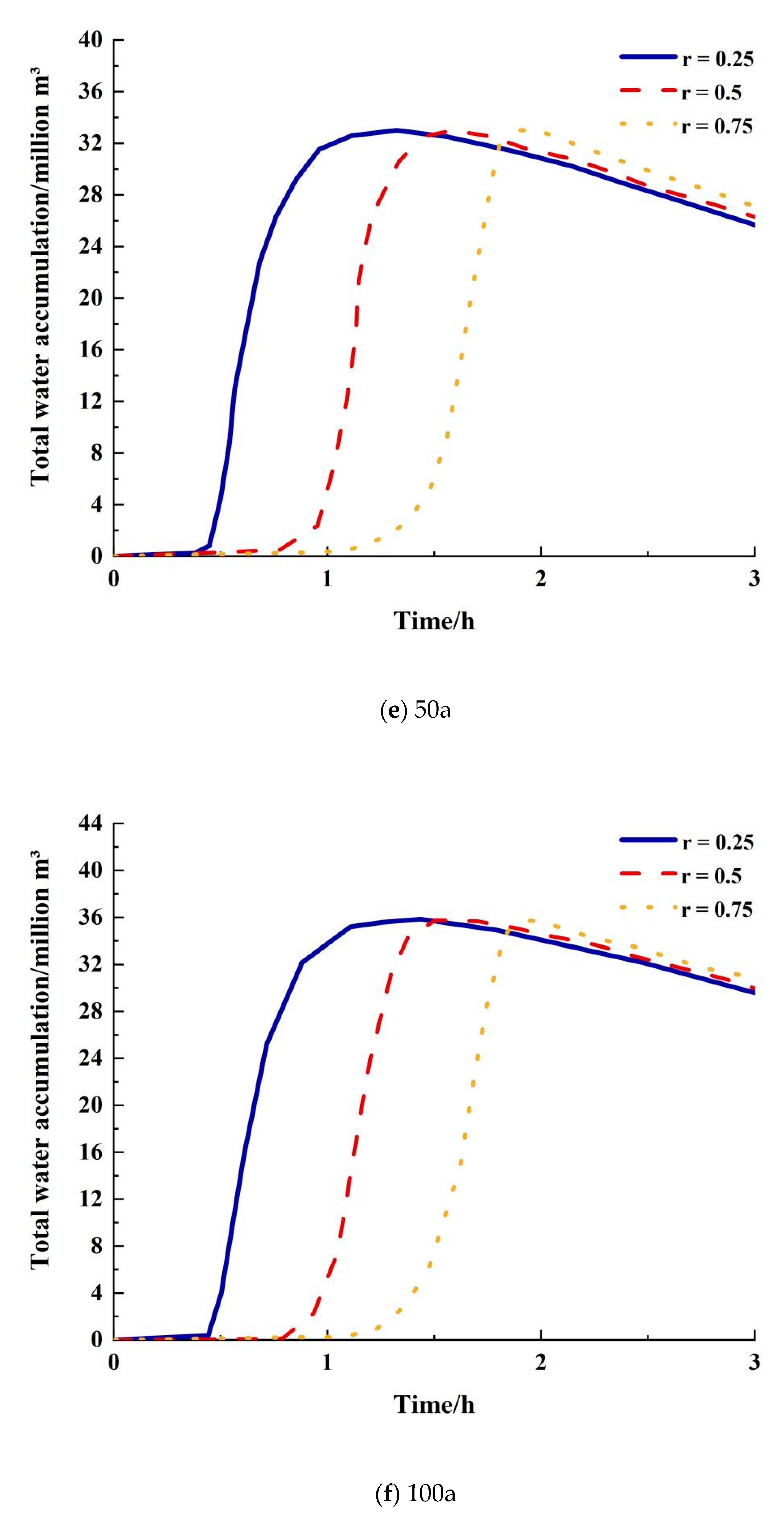
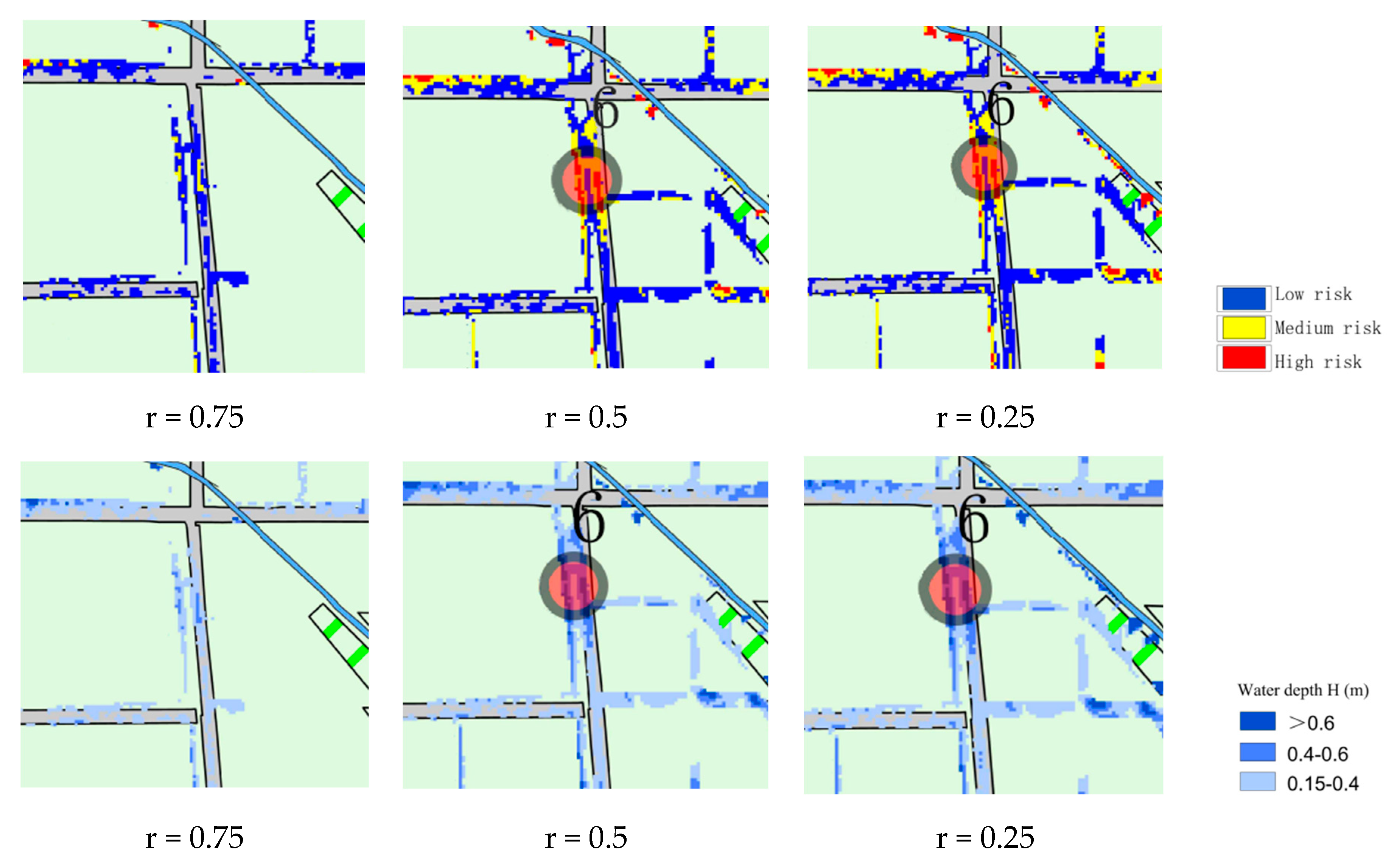
| Serial Number | Drainage Zoning | Surface Type (Subsurface) Area Statistics (ha) | |||||
|---|---|---|---|---|---|---|---|
| River Systems | Green Space | Transport Land | Building Sites | Agricultural and Forestry Land | Total | ||
| 1 | Jalu River Drainage Subdivision | 68.66 | 0 | 47.1 | 293.81 | 307.75 | 717.32 |
| 2 | Puddle Wash Drainage Subdivision | 32.28 | 57.17 | 108.21 | 705.24 | 1065.94 | 1968.84 |
| 3 | Sandy River Drainage Subdivision | 38.39 | 1.10 | 72.44 | 578.28 | 56.12 | 746.33 |
| 4 | Traffic Main Drainage Subdivision | 119.13 | 15.94 | 264.55 | 1088.98 | 684.98 | 2173.58 |
| 5 | Yang Brain Dry Drainage Subdivision | 2.40 | 31.58 | 51.28 | 342.71 | 147.27 | 575.24 |
| 6 | Canal Drainage Subdivision | 8.72 | 0 | 52.41 | 533.98 | 268.34 | 863.45 |
| Serial Number | Location of Ponded Water | Measured Water Depth/cm | Simulated Water Depth/cm | Difference/cm |
|---|---|---|---|---|
| 1 | Bayi Road North | 60 | 65 | 5 |
| 2 | Junction of Qi Yi Road and Da Qing Road | 40 | 42 | 2 |
| 3 | Near Gongnong Road and Yuxin Street | 55 | 58 | 3 |
| 4 | Intersection of Construction Road and Yinzhu Road | 30 | 31 | 1 |
| 5 | Area around Sanlian Hang | 80 | 76 | −4 |
| 6 | West Street Community | 80 | 84 | 4 |
| 7 | Jianxi Street area | 60 | 56 | 6 |
| 8 | Area near Anju Road | 40 | 45 | 5 |
| 9 | Fumin Road South area | 40 | 43 | 3 |
| 10 | Hanyang Road South area | 40 | 41 | 1 |
| 11 | Jiancai Road area | 40 | 38 | −2 |
| 12 | Gao Zhuang Community | 40 | 42 | 2 |
| 13 | Wenchang road | 60 | 58 | −2 |
| 14 | Bayi Road and Construction | 60 | 63 | 3 |
| 15 | Zhou Shi gate | 40 | 42 | 2 |
| 16 | Civil Service District A | 60 | 63 | 3 |
| 17 | Yuxin Street East | 40 | 42 | 2 |
| 18 | Tai Hao Road, Zijingcheng District | 35 | 39 | 4 |
| 19 | Junction of Chaoyang Road | 30 | 34 | 4 |
| 20 | Tai Hao Road, Wu Yi junction | 30 | 36 | 6 |
| Reproduction Period | V (r = 0.5) − V (r = 0.25)/m³ | V (r = 0.75) − V (r = 0.5)/m³ |
|---|---|---|
| 1 | −2627 | −3100 |
| 5 | −1543 | −2500 |
| 10 | −1287 | −1300 |
| 20 | 430 | 820 |
| 50 | 1150 | 2860 |
| 100 | 980 | 1982 |
| Reproduction Period/a | Peak Flooded Area/Million m² | Growth Rate/% | ||||
|---|---|---|---|---|---|---|
| r = 0.25 | r = 0.50 | r = 0.75 | r = 0.25 | r = 0.50 | r = 0.75 | |
| 1 | 1064.1 | 1125.8 | 1023.5 | 0 | 0 | 0 |
| 5 | 1367.8 | 1442.5 | 1347.6 | 28.54 | 28.13 | 31.67 |
| 10 | 1555.4 | 1621.5 | 1532.7 | 13.72 | 12.41 | 13.74 |
| 20 | 1674.3 | 1670.3 | 1623.6 | 7.64 | 3.01 | 5.93 |
| 50 | 1853.2 | 1923.4 | 1877.5 | 10.68 | 15.15 | 15.64 |
| 100 | 2001.5 | 2040.5 | 2023.2 | 8.00 | 6.08 | 7.76 |
Disclaimer/Publisher’s Note: The statements, opinions and data contained in all publications are solely those of the individual author(s) and contributor(s) and not of MDPI and/or the editor(s). MDPI and/or the editor(s) disclaim responsibility for any injury to people or property resulting from any ideas, methods, instructions or products referred to in the content. |
© 2023 by the authors. Licensee MDPI, Basel, Switzerland. This article is an open access article distributed under the terms and conditions of the Creative Commons Attribution (CC BY) license (https://creativecommons.org/licenses/by/4.0/).
Share and Cite
Chen, J.; Li, Y.; Zhang, C. The Effect of Design Rainfall Patterns on Urban Flooding Based on the Chicago Method. Int. J. Environ. Res. Public Health 2023, 20, 4245. https://doi.org/10.3390/ijerph20054245
Chen J, Li Y, Zhang C. The Effect of Design Rainfall Patterns on Urban Flooding Based on the Chicago Method. International Journal of Environmental Research and Public Health. 2023; 20(5):4245. https://doi.org/10.3390/ijerph20054245
Chicago/Turabian StyleChen, Jian, Yaowei Li, and Changhui Zhang. 2023. "The Effect of Design Rainfall Patterns on Urban Flooding Based on the Chicago Method" International Journal of Environmental Research and Public Health 20, no. 5: 4245. https://doi.org/10.3390/ijerph20054245
APA StyleChen, J., Li, Y., & Zhang, C. (2023). The Effect of Design Rainfall Patterns on Urban Flooding Based on the Chicago Method. International Journal of Environmental Research and Public Health, 20(5), 4245. https://doi.org/10.3390/ijerph20054245







